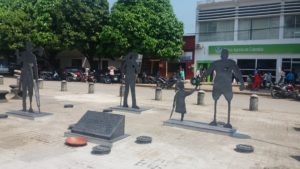Norbey Chavarro leads a group of landmine victims in Caquetá, a region in southeastern Colombia. Their association of victims of landmines is called United for Life (Unidos por la Vida).
This association works to give visibility to landmine victims and always invites others to work together. On September 13th in Florencia, they presented a set of sculptures designed by them to represent the memory and dignity of landmine victims and survivors. This memory initiative was the result of three months of hard work by eight landmine survivors in a mutual support group implemented by Blumont for their emotional recovery and the rehabilitation of their communities, as part of the Closing Gaps program.
Norbey’s speech passionately described the change in their lives:
Landmines are a threat that does not forgive and, much less, they cannot choose whom to affect, it does not matter if victims are common people, workers in farms, old, young or children, or if they work restlessly for our country. The most important thing is that this phenomenon is directly linked to the armed conflict we have lived with for many years in Colombia.
Many people have suffered and continue to live with the direct effects of landmines. There are also many family members that have suffered the loss of their loved ones. Others had to cope with multiple situations resulting from the loss or mutilation of limbs and organs.
That is why this memory initiative of the survivors of landmines in Caquetá is so important. It allowed us to create a space to memorialize the violent events and the difficult situations we went through; it was something not everyone was able to accept and that is why some of the participants of the group did not continue.
For those of us that continued, to accept this situation, to forgive ourselves and others, and to wait for time to heal the wounds that caused us so much pain, this memorial will allow us to continue with optimism, understanding that the gift of life is very valuable and that we now have new possibilities for our own and our families’ prosperity.
Today, with these representations, we want to remember, not with pain but with the hope for no person in our region and in our country to live the scourge of landmines, even more so now when demining is taking place in our territory.
Each one of these silhouettes represents a life story of the many survivors of landmines. Despite their situation, they want to show us that life goes on and that we must move on because there is always a road to walk, a job to do, and a goal to achieve. We may lose our limbs and organs but never our dreams and desire to live.
We hope that this is the beginning of many memory initiatives for all of us to have the opportunity to feel this transformation, to change the meaning of the landmine symbols that have been planted in this area for their new meaning as representations of hope, love, faith, tolerance, reconciliation, resiliency, equality, and education; these are values and emotions that reflect the fact that today we are landmine survivors.

Sculptures at the landmine victims memorial.
Blumont implements the Closing Gaps program in Florencia (Caquetá) and Popayán (Cauca) to improve assistance to victims of displacement and armed conflict in Colombia. The program is funded by the United States Department of State, Bureau of Population, Refugees, and Migration. In October 2015 – September 2016, 346 victims participated in 16 mutual support groups for their emotional recovery, and 16 memory initiatives were presented for the rehabilitation of their communities.
RELATED READING:



